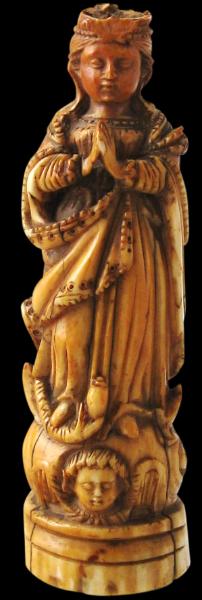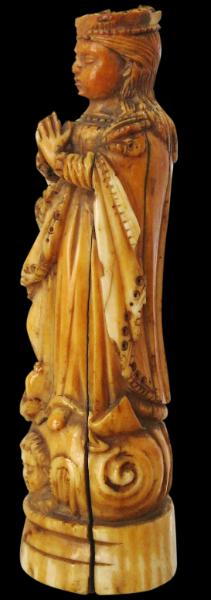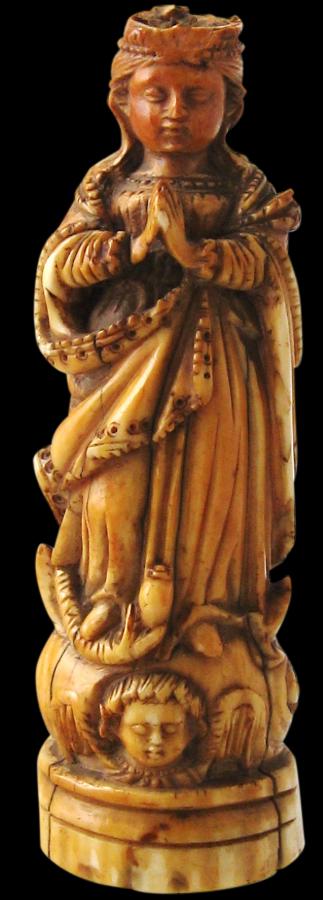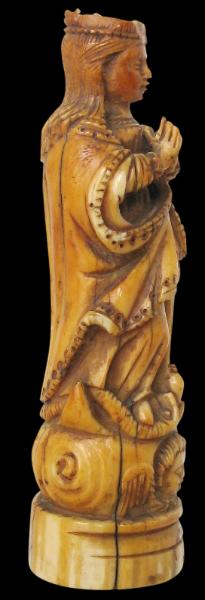
Goa Christian Ivory, Portuguese Colonial India
Carved Ivory Virgin of the Immaculate Conception (Nossa Senhora da Conceicao)
Goa, India
17th century
height: 10.8cm, weight: 68g
This image of the Virgin of the Immaculate Conception is of a single piece of carved ivory over a wood core. The Virgin stands with her hands clasped in prayer. She wears a sari-like tunic delicately carved with ample folds and edges embellished with crinkles and roundels. Her carefully rendered face is framed with long flowing hair. She steps with her right foot on a serpent, all atop a cloud-like sphere decorated with the face of a seraphim. Unusually, the serpent emits a conch shell from its mouth – an Indian addition to the imagery. Parallels too can be drawn between images of the infant Krishna who also often is depicted with one foot standing on a snake. The Virgin stands also on a crescent moon, the points of which protrude upwards almost as wings on either side of her feet. Metaphorically, she is bathed in light, a point emphasised by her standing over the moon. But equally, the crescent can be seen as symbolising the Islamic crescent and Christendom’s victory over the Turks at the Battle of Lepanto.
This image shows several characteristics of Portuguese-Indian carving. The beautifully shaped face with its delicate, short nose, the sari-like costume, the long strands of hair, and the crown (now missing – most probably it was made of metal, perhaps silver). The position of the hands are both in the form of Christian prayer but also the
anjali mudhra position found in many Hindu Indian bronzes.
The veneration of the Virgin Many was a significant component of the iconography mandated by the Council of Trent, hence the large numbers of images of the Virgin in churches in Europe and in Portugal’s overseas possessions such as Goa. This precise formulation of the Virgin, as the Virgin of the Immaculate Conception, derives from Portugal’s King Joao IV’s declaration of the Virgin of the Immaculate Conception as the benefactress of the kingdom, following the restoration of Portugal’s independence in 1640, which lead to the appearance of crowned images of this form of the Virgin.
Goa came under the governance of the Delhi Sultanate in 1312. But the Sultanate’s hold on the region was weak. By 1370, the region was surrendered to the Vijayanagara empire. The Vijayanagara monarchs held the territory until 1469, when it fell to the Bahmani sultans of Gulbarga. With the fall of that dynasty, the area fell to the Adil Shahis of Bijapur who established as their auxiliary capital the city known under the Portuguese as Velha Goa. In 1510, the Portuguese defeated the ruling Bijapur kings with the help of a local ally, Timayya. They founded a permanent settlement in Velha Goa (Old Goa) and Christianity arrived to Goa.
The Portuguese expanded their possessions around the region so that by mid-18th century the area under occupation had expanded to most of Goa’s present day state limits. In 1843 the capital was moved to Panjim from Velha Goa.
After India gained independence from in 1947, Portugal refused to negotiate with India on the transfer of sovereignty of their Indian enclaves. In December 1961, the Indian army annexed Goa and several smaller Portuguese possessions, ending Portugal’s 400 year presence in the Indian sub-continent.
Many Goans converted to Christianity under the Portuguese. Local religious art developed syncreatic elements: it was predominantly Christian but incorporated Hindu Indian influences. The Jesuits played a critical role in Goa: Francis Xavier, the Spanish-born pioneering Roman Catholic and co-founder of the Society of Jesus (the Jesuits) was ordered by Ignatius Loyola, the principal founder of the Jesuits, on behalf of the Portuguese king to undertake a mission to the Portuguese East Indies. The king had become concerned that Christian values in the possessions had become deteriorated. Xavier left Lisbon in April 1541, and after first visiting Mozambique he reached Goa in May 1542, where he spent the next three years strengthening the position of the Church. Thereafter, the Jesuits played a key role in developing the Church’s infrastructure of Goa: churches, monasteries and Catholic schools were built.
References
Museu Nacional de Arte Antiga, Portugal and the World: In the 16th and 17th Centuries, MNAA, 2009; Comissao Nacional para as Comemoracoes dos Descobrimentos Portugueses, Os Construtores do Oriente Portugues, 1998; Galeriade Pintura do rei D. Luis I, Obros de Referencia dos Museus da Madeira, 2009; and La Route des Indes, Musee des Artes Decoratifs, 1998.
Inventory no.: 953
SOLD








